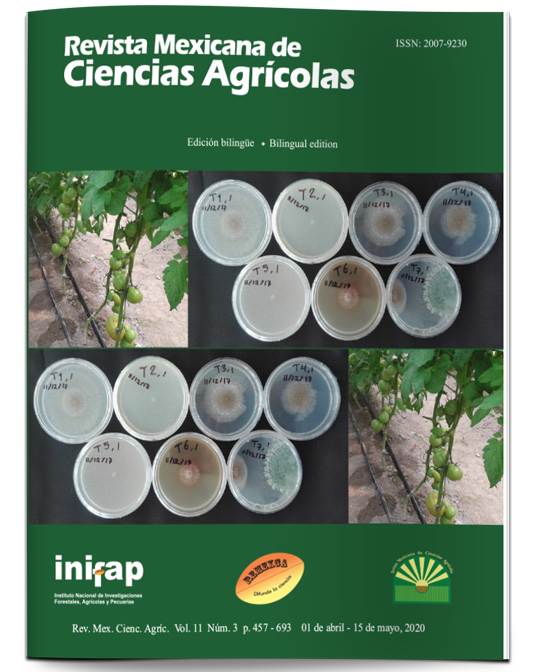Phenology and content of capsaicinoids in chili fruits produced under greenhouse conditions
DOI:
https://doi.org/10.29312/remexca.v11i3.2159Keywords:
Capsicum spp., capsaicin, dihydrocapsaicin, growth, total capsaicinoids, yieldAbstract
In the present investigation, the development and yield of 10 chili genotypes were evaluated under greenhouse conditions and in the laboratory the content of capsaicinoids in fruits with different stages of maturity was determined, coming from seven municipalities in the state of Puebla. The work was carried out at the Faculty of Agrohydraulic Engineering of the Benemerita Autonomous University of Puebla, San Juan Acateno, Teziutlan, Puebla. The experimental design used was complete random blocks with four repetitions. Phenology variables were recorded and the content of capsaicin and dihydrocapsaicin was determined by high performance liquid chromatography (HPLC). The Cera Amarillo chili had the highest growth cycle (4 360 degrees day, p≤ 0.05) among all genotypes, while Cera Rojo registered the maximum weight of the fruit (795 g, p≤ 0.05), attributed to its greater diameter and average weight. The highest content of capsaicin, dihydrocapsaicin and total capsaicinoids (2.65, 0.49 and 2.99 mg g-1, respectively) was presented in the state of commercial maturity of the fruits. The Mirasol chilli showed greater stability in the content of capsaicin, dihydrocapsaicin and total capsaicinoids when changing from the state of physiological maturity to commercial.
Downloads
Published
How to Cite
Issue
Section
License
The authors who publish in Revista Mexicana de Ciencias Agrícolas accept the following conditions:
In accordance with copyright laws, Revista Mexicana de Ciencias Agrícolas recognizes and respects the authors’ moral right and ownership of property rights which will be transferred to the journal for dissemination in open access. Invariably, all the authors have to sign a letter of transfer of property rights and of originality of the article to Instituto Nacional de Investigaciones Forestales, Agrícolas y Pecuarias (INIFAP) [National Institute of Forestry, Agricultural and Livestock Research]. The author(s) must pay a fee for the reception of articles before proceeding to editorial review.
All the texts published by Revista Mexicana de Ciencias Agrícolas —with no exception— are distributed under a Creative Commons License Attribution-NonCommercial 4.0 International (CC BY-NC 4.0), which allows third parties to use the publication as long as the work’s authorship and its first publication in this journal are mentioned.
The author(s) can enter into independent and additional contractual agreements for the nonexclusive distribution of the version of the article published in Revista Mexicana de Ciencias Agrícolas (for example include it into an institutional repository or publish it in a book) as long as it is clearly and explicitly indicated that the work was published for the first time in Revista Mexicana de Ciencias Agrícolas.
For all the above, the authors shall send the Letter-transfer of Property Rights for the first publication duly filled in and signed by the author(s). This form must be sent as a PDF file to: revista_atm@yahoo.com.mx; cienciasagricola@inifap.gob.mx; remexca2017@gmail.
This work is licensed under a Creative Commons Attribution-Noncommercial 4.0 International license.



